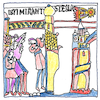Edmond Halley
astronomy

|
Halley’s comet
Edmond Halley was interested in proving Kepler’s laws of planetary motion. He went to Cambridge to discuss this with Isaac Newton, only to find that Newton had already formulated his laws of motion and universal gravitation and derived Kepler’s laws from these. Halley paid to publish Newton’s Philosophiæ Naturalis Principia Mathematica and began to apply Newton’s laws to explain the effects of Jupiter and Saturn on the orbits of comets, and to connect historical observations. Since 240 BCE, Chinese, Babylonian, and medieval European astronomers recorded the appearance of comets, but separate observations were not connected to the same object. In 1705, in his Synopsis of the Astronomy of Comets, Halley connected Petrus Apianus’ observation in 1531 and Johannes Kepler’s observation in 1607 with the second comet observed in 1682 and predicted its return after 76 years. When it returned as predicted it was named after him.
Apparitions
Appearances of Halley’s comet since 240 BCE were chronicled by the Chinese who called it the broom star. In 164 BCE, in Babylon, Halley’s comet was recorded in cuneiform on a clay tablet now in the British Museum. The Annals of Ulster noted in 912, “A dark and rainy year. A comet appeared.” In an English woodcut from 1531, Halley’s comet appears as a series of yellow fuzzballs with thick brown straw-like tails. The Bayeux Tapestry depicts the appearance of Halley’s comet in 1066 as a spiky brown ball at the head of a rake with streamers. The appearance in 1066 was also described in the Anglo-Saxon Chronicle by Eilmer of Malmesbury and the Irish Annals of the Four Masters. In 1470 the humanist scholar Bartolomeo Platina wrote in his Lives of the Popes of a “hairy and fiery star.” Halley’s comet passed so close to the earth in 1910 that astronomer Camille Flammarion warned cyanogen in the tail would poison all life. Its only appearance during my lifetime was 1986 but it was far from the earth and appeared on the other side of the sun. If great things have passed me by at least I can hope I have tuned to the sounds of their passing.
Perturbations
The orbit of the comet is perturbed in passing by Jupiter, Saturn, Uranus, and Neptune. A president is murdered; a war is lost; millions die of famine, hurricane, tsunami. You are inspired by the music of a rock band; a loved one dies; you write a book.



Halley not only predicted the reappearance of the comet but in doing so helped banish superstition and ignorance regarding such unusual heavenly apparitions. In 1066 Eilmer of Malmesbury wrote, “I see you brandishing the downfall of my country. I hate you!” In 1470 Bartolomeo Platina wrote, “A hairy and fiery star having then made its appearance for several days, the mathematicians declared that there would follow grievous pestilence, dearth and some great calamity.” We might expect medieval monks to be susceptible to superstition, but not mathematicians. Even so, we are all human, and so in 1910 many bought anti-comet pills and anti-comet umbrellas to assuage their susceptibilities.
See also in The book of science:
Readings in wikipedia:
Other readings: